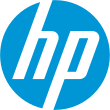
Compaq Computer Corporation was an American information technology company founded in 1982 that developed, sold, and supported computers and related products and services. Compaq produced some of the first IBM PC compatible computers, being the second company after Columbia Data Products to legally reverse engineer the BIOS of the IBM Personal Computer. It rose to become the largest supplier of PC systems during the 1990s before being overtaken by Dell in 2001. Struggling to keep up in the price wars against Dell, as well as with a risky acquisition of DEC, Compaq was acquired for US$25 billion by HP in 2002. The Compaq brand remained in use by HP for lower-end systems until 2013 when it was discontinued. Since 2013, the brand is currently licensed to third parties for use on electronics in Brazil and India.

A workstation is a special computer designed for technical or scientific applications. Intended primarily to be used by a single user, they are commonly connected to a local area network and run multi-user operating systems. The term workstation has been used loosely to refer to everything from a mainframe computer terminal to a PC connected to a network, but the most common form refers to the class of hardware offered by several current and defunct companies such as Sun Microsystems, Silicon Graphics, Apollo Computer, DEC, HP, NeXT, and IBM which powered the 3D computer graphics revolution of the late 1990s.

A Pocket PC is a class of personal digital assistant (PDA) that runs the Windows Mobile or Windows Embedded Compact operating system that has some of the abilities of modern desktop PCs. The name was introduced by Microsoft in 2000 as a rebranding of the Palm-size PC category. Some of these devices also had integrated phone and data capabilities, which were called Pocket PC Phone Edition. Windows "Smartphone" is another Windows CE based platform for non-touch flip phones or dumber phones.

Dell Inc. is an American technology company that develops, sells, repairs, and supports computers and related products and services. Dell is owned by its parent company, Dell Technologies.

Marc Lowell Andreessen is an American businessman and software engineer. He is the co-author of Mosaic, the first widely used web browser with a graphical user interface; co-founder of Netscape; and co-founder and general partner of Silicon Valley venture capital firm Andreessen Horowitz. He co-founded and later sold the software company Opsware to Hewlett-Packard. Andreessen is also a co-founder of Ning, a company that provides a platform for social networking websites and an inductee in the World Wide Web Hall of Fame. Andreessen's net-worth is estimated at $1.7 billion.
eMachines was a brand of economical personal computers. In 2004, it was acquired by Gateway, Inc., which was in turn acquired by Acer Inc. in 2007. The EMachines brand was discontinued in 2013.

A handheld personal computer (PC), typically built around either a clamshell form factor or a gaming form factor with a gamepad integrated for video games, is a mobile device that is significantly smaller than any standard personal computer (PC), but based on the same principles as PCs. The clamshell form factor is sometimes referred to as a palmtop computer, not to be confused with Palmtop PC which was a name used mainly by Hewlett-Packard.
Voodoo Computers Inc. or VoodooPC was a luxury personal computer brand and company. Voodoo was originally started as a niche PC maker in Calgary, Alberta, Canada. It was founded in 1991, and acquired by Hewlett-Packard in 2006. Voodoo specialized in desktop high performance computing. By 2013 the Voodoo name was no longer used, and was replaced by the brand name Omen, which used the same logo until 2020.

The Jornada was a line of personal digital assistants or PDAs manufactured by Hewlett-Packard. The Jornada was a broad product line that included Palm-Size PCs, Handheld PCs, and Pocket PCs. The first model was the 820, released in 1998, and the last was the 928 model in 2002 when Compaq and HP merged. The Jornada line was then succeeded by the more popular iPAQ model PDAs. All Jornada models ran Microsoft Operating Systems that were based on Windows CE.

The HP-15C is a high-end scientific programmable calculator of Hewlett-Packard's Voyager series produced between 1982 and 1989.
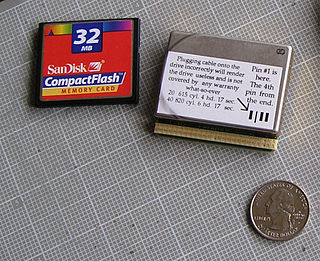
The Hewlett-Packard HP3013/3014, nicknamed Kittyhawk, was a hard disk drive introduced by Hewlett-Packard on June 9, 1992. At the time of its introduction, it was the smallest hard disk drive in the world, being only 1.3-inches in size. The drive was created by a collaboration between Hewlett-Packard, AT&T, and Citizen Watch.
Vyomesh "VJ" Joshi was 3D Systems CEO and president, and was the executive vice president of Hewlett-Packard Company's Imaging and Printing Group. He also served as the executive sponsor for all HP operations and initiatives in India and was a member of HP's executive council.

The Hewlett-Packard Company, commonly shortened to Hewlett-Packard or HP, was an American multinational information technology company headquartered in Palo Alto, California. HP developed and provided a wide variety of hardware components, as well as software and related services to consumers, small and medium-sized businesses (SMBs), and large enterprises, including customers in the government, health, and education sectors. The company was founded in a one-car garage in Palo Alto by Bill Hewlett and David Packard in 1939, and initially produced a line of electronic test and measurement equipment. The HP Garage at 367 Addison Avenue is now designated an official California Historical Landmark, and is marked with a plaque calling it the "Birthplace of 'Silicon Valley'".
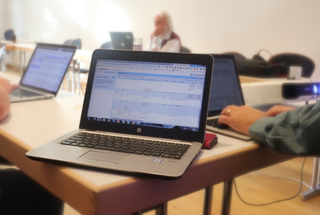
HP EliteBook is a line of business-oriented high-end laptops and previously mobile workstations made by Hewlett-Packard. The EliteBook series, which fits above the small business ProBook series, was introduced in August 2008 as a replacement of the HP Compaq high end line of business laptops. The EliteBook brand included mobile workstations until September 2013, when they were rebranded as HP ZBook. The EliteBook mainly competes against computer lineups such as Acer's TravelMate, Dell's Latitude, Lenovo's ThinkPad and Toshiba's Portégé and Tecra.

A Palmtop PC was an approximately pocket calculator-sized, battery-powered computer compatible with the IBM Personal Computer in a horizontal clamshell design with integrated keyboard and display. It could be used like a subnotebook, but was light enough to be comfortably used handheld as well. Most Palmtop PCs were small enough to be stored in a user's shirt or jacket pockets.

HP Vectra was a line of business-oriented personal computers manufactured by Hewlett-Packard. It was introduced in October 1985 as HP's first IBM-compatible PC.
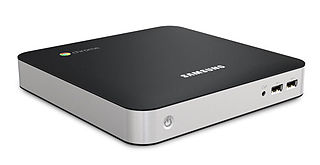
A Chromebox is a small form-factor PC that runs Google's ChromeOS operating system. The first device debuted in May 2012.
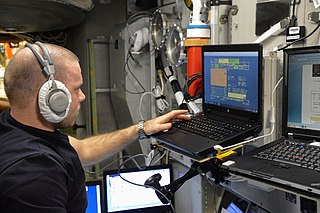
HP ZBook is a brand of mobile workstations made by HP Inc. Introduced in September 2013, it is a successor to HP's previous mobile workstations in the HP EliteBook series. The ZBook mainly competes against PCs such as Dell's Precision and Lenovo's ThinkPad P series.

HP Inc. is an American multinational information technology company headquartered in Palo Alto, California, that develops personal computers (PCs), printers and related supplies, as well as 3D printing services. It was formed on November 1, 2015, as the legal successor of the original Hewlett-Packard after the company's enterprise product and business services divisions were spun off as a new publicly traded company, Hewlett Packard Enterprise.

Kayak was a line of x86-based, optionally dual-processor workstation computers released by Hewlett-Packard from 1997 until the acquisition of Compaq in 2002. The Kayak line was aimed at the scientific computing and professional 3D graphics markets and came preinstalled with Windows NT.

















